or truncated ~ http://gu.com/p/3ebbm/tw ~via @guardian
From the election of Allende in Chile, socialist-leaning leaders have remoulded the continent to a very different shape from that envisaged by the CIA a generation ago
The Observer,
Forty years of struggle for Latin America's left …
Death of Allende (1973)
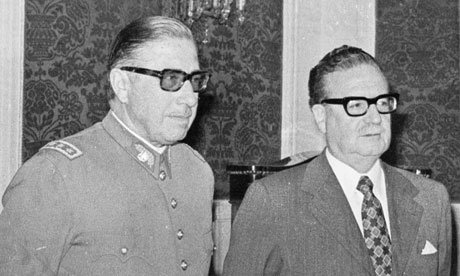 General Augusto Pinochet, left, and President Salvador Allende attend a ceremony naming Pinochet as commander in chief of the army. Photograph: Enrique Aracena/AP Salvador Allende, president of Chile, died in the presidential palace on 11 September 1973 during a coup led by army chief Augusto Pinochet. Allende won the presidency in 1970 and became Latin America's first democratically elected leftwing leader. The CIA, which played an active part in Chilean politics in the 70s, sought Allende's overthrow before he took office in 1970, but the US disputes that it was involved in the military coup.
General Augusto Pinochet, left, and President Salvador Allende attend a ceremony naming Pinochet as commander in chief of the army. Photograph: Enrique Aracena/AP Salvador Allende, president of Chile, died in the presidential palace on 11 September 1973 during a coup led by army chief Augusto Pinochet. Allende won the presidency in 1970 and became Latin America's first democratically elected leftwing leader. The CIA, which played an active part in Chilean politics in the 70s, sought Allende's overthrow before he took office in 1970, but the US disputes that it was involved in the military coup.Operation Condor (1970s-1980s)
A campaign of political repression carried out by US-backed Latin American dictatorships in the 70s and 80s that was designed to eliminate tens of thousands of leftwing activists. It was the idea of Chilean dictator Augusto Pinochet, who enlisted Argentina, Bolivia, Paraguay, Uruguay and Brazil in a continent-wide campaign. Last week, in Buenos Aires, 25 people with links to Operation Condor went on trial on charges of torture, kidnapping and criminal association.The Sandinista Revolution (1979)
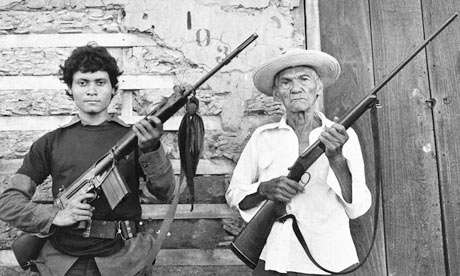 An 87-year-old veteran of the first Sandino rebellion stands with an 18-year-old Sandinista guerrilla in Leon, Nicaragua, June 19, 1979. Photograph: Richard Cross/AP The Sandinista National Liberation Front overthrew Anastasio Somoza's dictatorship in July 1979 and established a socialist coalition government. The Somoza family had ruled Nicaragua from 1936 to 1979. Somoza allegedly embezzled funds sent to help rebuild the capital, Managua, after an earthquake in 1972. Shortly thereafter the Catholic church became a vocal critic of Somoza.
An 87-year-old veteran of the first Sandino rebellion stands with an 18-year-old Sandinista guerrilla in Leon, Nicaragua, June 19, 1979. Photograph: Richard Cross/AP The Sandinista National Liberation Front overthrew Anastasio Somoza's dictatorship in July 1979 and established a socialist coalition government. The Somoza family had ruled Nicaragua from 1936 to 1979. Somoza allegedly embezzled funds sent to help rebuild the capital, Managua, after an earthquake in 1972. Shortly thereafter the Catholic church became a vocal critic of Somoza.The Contras (1979-90)
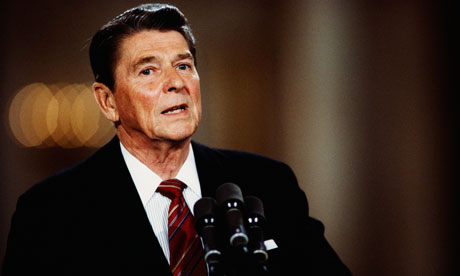 United States President Ronald Reagan giving a speech in Washington, DC in 1984. Photograph: Shepard Sherbell/ Shepard Sherbell/CORBIS SABA Rightwing rebel groups formed in opposition to the Sandinistas, the Contras received aid from the US government – for arms and training – until aid was outlawed by Congress. The administration of Ronald Reagan, above – which had come to power in 1981 committed to supporting rightwing regimes in Latin America – attempted to fund the groups covertly. The Contras-Sandinista conflict was seen by many as a proxy for the cold war that reached renewed heights during the Reagan administration.
United States President Ronald Reagan giving a speech in Washington, DC in 1984. Photograph: Shepard Sherbell/ Shepard Sherbell/CORBIS SABA Rightwing rebel groups formed in opposition to the Sandinistas, the Contras received aid from the US government – for arms and training – until aid was outlawed by Congress. The administration of Ronald Reagan, above – which had come to power in 1981 committed to supporting rightwing regimes in Latin America – attempted to fund the groups covertly. The Contras-Sandinista conflict was seen by many as a proxy for the cold war that reached renewed heights during the Reagan administration.The killing of Archbishop Romero/El Salvador civil war (1980-92)
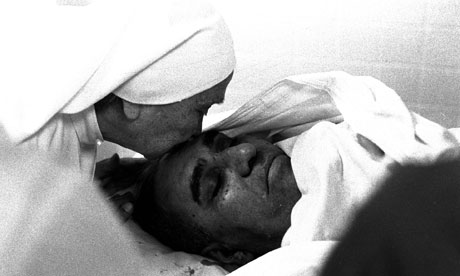
A nun plants a kiss on the forehead of assassinated Archbishop Oscar Arnulfo Romero at the Hospital of Divine Providence in San Salvador, March 25, 1980. Photograph: Eduardo Vazquez Becker/AP The archbishop of San Salvador, Óscar Romero had been an outspoken critic of the junta attempting to quell a popular insurrection whose leaders were advocating social and economic reforms. Romero alleged that the junta was guilty of massacres and torture. The archbishop was assassinated on 24 March 1980. Rallies in support of Romero turned bloody when police opened fire on the crowds. This was the spark for the 12-year El Salvador civil war. The military, supported by the US, targeted union officials, clergy, academics and others; thousands died. A peace agreement was reached between the two groups in 1992.
Guatemalan civil war (1960-96)
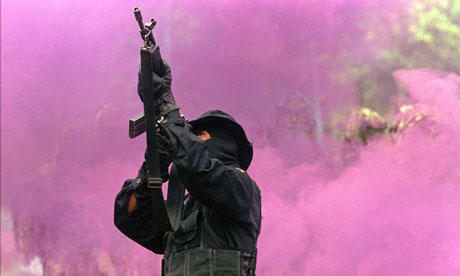
A kaibile soldier shoots into the air in remembrance of fallen soldiers. Photograph: Moises Castillo/Associated Press The Central American state endured a long and bloody conflict between government and leftwing rebels. Its roots date back to the mid-40s when the US helped overthrow the October Revolutionaries – leftwing students and professionals advancing radical social and economic reforms. The CIA-backed coup in 1954 put an end to this reforming zeal. In the 80s, the junta aimed to systematically eliminate leftwing activists throughout civil society – the universities, politics, law, peasants, etc. More than 200,000 died and many more disappeared. In December 1996, ex-rebel leader Rolando Morán and the president, Álvaro Arzú, signed peace accords.
Fidel Castro (Cuban leader, 1959-2008)
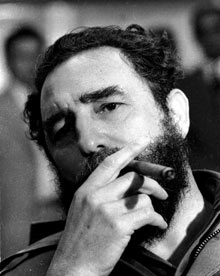
Photograph: Prensa Latina/Reuters From 1976 until 2008, Castro was an inspiration for a generation of Latin Americans who warmed to his anti-imperialist, socialist agenda. By the mid 2000s, the continent had seen the rise of what became known as the "pink tide" (ie, something less than red-blooded socialism). Castro formed alliances and friendships with many leaders – Chávez in Venezuela, Lula in Brazil, Morales in Bolivia and Correa in Ecuador. A BBC report in 2005 estimated that, of 350 million Latin Americans, three out of four lived under leftwing administrations – a dramatic break with the era when the continent was governed by leaders sympathetic to, and supported by, the US.
… And the rise of the democratic left since 1999
 Chavez Photograph: Reuters/Corbis Hugo Chávez was among the first of the late 20th-century Latin American leaders who came to power with a leftwing agenda. Chávez looked to Simón Bolívar – godfather of South American independence – for inspiration for his Latin socialism. He was elected president of Venezuela in 1999 and served until his death last week.
Chavez Photograph: Reuters/Corbis Hugo Chávez was among the first of the late 20th-century Latin American leaders who came to power with a leftwing agenda. Chávez looked to Simón Bolívar – godfather of South American independence – for inspiration for his Latin socialism. He was elected president of Venezuela in 1999 and served until his death last week. Elected president of Brazil in 2002 and re-elected in 2006, the former union leader Luiz Inácio Lula da Silva promised major social reforms and oversaw the emergence of Brazil as an economic powerhouse, which did much to raise millions of people in the country out of poverty.
Elected president of Brazil in 2002 and re-elected in 2006, the former union leader Luiz Inácio Lula da Silva promised major social reforms and oversaw the emergence of Brazil as an economic powerhouse, which did much to raise millions of people in the country out of poverty. Tabaré Vázquez, an oncologist, was elected president of Uruguay in October 2004. A member of the Socialist party, he became the country's first president from a leftwing party. One of his first actions was to announce a $100m-a-year project to alleviate extreme poverty.
Tabaré Vázquez, an oncologist, was elected president of Uruguay in October 2004. A member of the Socialist party, he became the country's first president from a leftwing party. One of his first actions was to announce a $100m-a-year project to alleviate extreme poverty. Michelle Bachelet's election as president of Chile in 2006 was significant for a number of reasons. She was the first woman president, she was a social democrat, and her father, General Alberto Bachelet, who served under Allende, had been tortured by, and died during, the Pinochet dictatorship.
Michelle Bachelet's election as president of Chile in 2006 was significant for a number of reasons. She was the first woman president, she was a social democrat, and her father, General Alberto Bachelet, who served under Allende, had been tortured by, and died during, the Pinochet dictatorship. Evo Morales, elected president of Bolivia in 2006, is a champion of indigenous rights and a vocal critic of US foreign policy. He has committed himself to widespread land reforms that would help the poorest peasant farmers and to ensuring that the wealth from the country's gas reserves is distributed more equally.
Evo Morales, elected president of Bolivia in 2006, is a champion of indigenous rights and a vocal critic of US foreign policy. He has committed himself to widespread land reforms that would help the poorest peasant farmers and to ensuring that the wealth from the country's gas reserves is distributed more equally. Rafael Correa, elected in 2006 as president of Ecuador and re-elected last month for a second term. He is an economist who came to power on the back of his opposition to the International Monetary Fund's plans for remedying his country's economic ills. Instead, he rolled back the IMF plans and put an end to privatisation of national resources such as water, oil and gas.
Rafael Correa, elected in 2006 as president of Ecuador and re-elected last month for a second term. He is an economist who came to power on the back of his opposition to the International Monetary Fund's plans for remedying his country's economic ills. Instead, he rolled back the IMF plans and put an end to privatisation of national resources such as water, oil and gas.In Ecuador – as in Venezuela – many groups assert that the president is developing an authoritarian streak that endangers human rights and the freedom of the media.
++++++++++++++++++++++++++++++++++++++++
HELP-Matrix Humane-Liberation-Party Blog ~ http://help-matrix.blogspot.com/ ~
Humane-Liberation-Party Portal ~ http://help-matrix.ning.com/ ~
@Peta_de_Aztlan Blog ~ http://peta-de-aztlan.blogspot.com/ ~ @Peta_de_Aztlan
+++++++++++++++++++++++++++++++++++++++++

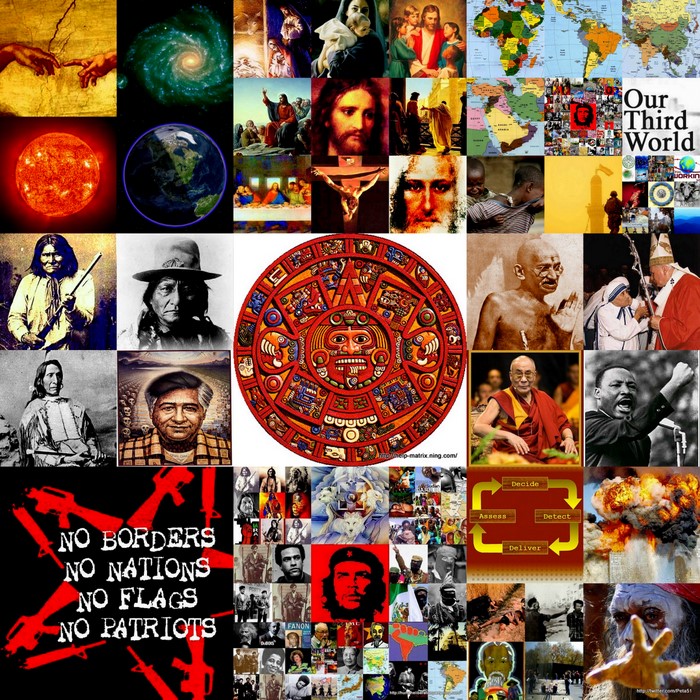
No comments:
Post a Comment
Please keep comments humane!